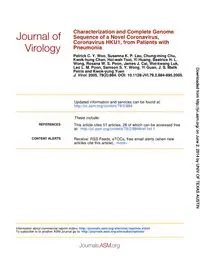
2005 Characterization and Complete Genome Sequence of a Novel Coronavirus, Coronavirus HKU1, from Patients with Pneumoni PDF
Preview 2005 Characterization and Complete Genome Sequence of a Novel Coronavirus, Coronavirus HKU1, from Patients with Pneumoni
2005, 79(2):884. DOI: 10.1128/JVI.79.2.884-895.2005. J. Virol. Peiris and Kwok-yung Yuen Leo L. M. Poon, Samson S. Y. Wong, Yi Guan, J. S. Malik Wong, Rosana W. S. Poon, James J. Cai, Wei-kwang Luk, Kwok-hung Chan, Hoi-wah Tsoi, Yi Huang, Beatrice H. L. Patrick C. Y. Woo, Susanna K. P. Lau, Chung-ming Chu, Pneumonia Coronavirus HKU1, from Patients with Sequence of a Novel Coronavirus, Characterization and Complete Genome http://jvi.asm.org/content/79/2/884 Updated information and services can be found at: These include: REFERENCES http://jvi.asm.org/content/79/2/884#ref-list-1 at: This article cites 51 articles, 26 of which can be accessed free CONTENT ALERTS more» articles cite this article), Receive: RSS Feeds, eTOCs, free email alerts (when new http://journals.asm.org/site/misc/reprints.xhtml Information about commercial reprint orders: http://journals.asm.org/site/subscriptions/ To subscribe to to another ASM Journal go to: on June 2, 2014 by UNIV OF TEXAS AUSTIN http://jvi.asm.org/ Downloaded from on June 2, 2014 by UNIV OF TEXAS AUSTIN http://jvi.asm.org/ Downloaded from JOURNAL OF VIROLOGY, Jan. 2005, p. 884–895 Vol. 79, No. 2 0022-538X/05/$08.00�0 doi:10.1128/JVI.79.2.884–895.2005 Copyright © 2005, American Society for Microbiology. All Rights Reserved. Characterization and Complete Genome Sequence of a Novel Coronavirus, Coronavirus HKU1, from Patients with Pneumonia Patrick C. Y. Woo,1,2† Susanna K. P. Lau,1,2† Chung-ming Chu,3 Kwok-hung Chan,1 Hoi-wah Tsoi,1 Yi Huang,1 Beatrice H. L. Wong,1 Rosana W. S. Poon,1 James J. Cai,1 Wei-kwang Luk,4 Leo L. M. Poon,1,2 Samson S. Y. Wong,1,2 Yi Guan,1,2 J. S. Malik Peiris,1,2 and Kwok-yung Yuen1,2†* Department of Microbiology1 and State Key Laboratory of Emerging Infectious Diseases,2 The University of Hong Kong, Division of Respiratory Medicine, Department of Medicine, United Christian Hospital,3 and Department of Microbiology, Tseung Kwan O Hospital,4 Hong Kong Received 29 July 2004/Accepted 3 September 2004 Despite extensive laboratory investigations in patients with respiratory tract infections, no microbiological cause can be identified in a significant proportion of patients. In the past 3 years, several novel respiratory viruses, including human metapneumovirus, severe acute respiratory syndrome (SARS) coronavirus (SARS- CoV), and human coronavirus NL63, were discovered. Here we report the discovery of another novel corona- virus, coronavirus HKU1 (CoV-HKU1), from a 71-year-old man with pneumonia who had just returned from Shenzhen, China. Quantitative reverse transcription-PCR showed that the amount of CoV-HKU1 RNA was 8.5 to 9.6 � 106 copies per ml in his nasopharyngeal aspirates (NPAs) during the first week of the illness and dropped progressively to undetectable levels in subsequent weeks. He developed increasing serum levels of specific antibodies against the recombinant nucleocapsid protein of CoV-HKU1, with immunoglobulin M (IgM) titers of 1:20, 1:40, and 1:80 and IgG titers of <1:1,000, 1:2,000, and 1:8,000 in the first, second and fourth weeks of the illness, respectively. Isolation of the virus by using various cell lines, mixed neuron-glia culture, and intracerebral inoculation of suckling mice was unsuccessful. The complete genome sequence of CoV-HKU1 is a 29,926-nucleotide, polyadenylated RNA, with G�C content of 32%, the lowest among all known coronaviruses with available genome sequence. Phylogenetic analysis reveals that CoV-HKU1 is a new group 2 coronavirus. Screening of 400 NPAs, negative for SARS-CoV, from patients with respiratory illness during the SARS period identified the presence of CoV-HKU1 RNA in an additional specimen, with a viral load of 1.13 � 106 copies per ml, from a 35-year-old woman with pneumonia. Our data support the existence of a novel group 2 coronavirus associated with pneumonia in humans. Since no microbiological cause can be identified for a sig- nificant proportion of patients with respiratory tract infections (18, 29), research has been conducted to identify novel agents. Of the three novel agents identified in recent 3 years, including human metapneumovirus (36), severe acute respiratory syn- drome (SARS) coronavirus (SARS-CoV) (25), and human coronavirus NL63 (HCoV-NL63) (6, 37), two were coronavi- ruses. Coronaviruses possess the largest genomes of all RNA viruses, consisting of about 30 kb. As a result of their unique mechanism of viral replication, coronaviruses have a high fre- quency of recombination. Based on genotypic and serological characterization, coro- naviruses were divided into three distinct groups, with human coronavirus 229E (HCoV-229E) being a group 1 coronavirus and human coronavirus OC43 (HCoV-OC43) being a group 2 coronavirus (16). They account for 5 to 30% of human respi- ratory tract infections. In late 2002 and 2003, the epidemic caused by SARS-CoV affected more than 8,000 people with 750 deaths (23–25, 44, 45, 51). We have also reported the isolation of SARS-CoV-like viruses from Himalayan palm civ- ets, which suggested that animals could be the reservoir for the ancestor of SARS-CoV (9). On the basis of genome analysis, SARS-CoV belonged to a fourth coronavirus group or alter- natively was a distant relative of group 2 coronaviruses (4, 20, 28, 31, 48). Recently, a novel group 1 human coronavirus associated with respiratory tract infections, HCoV-NL63, was discovered, and its genome was sequenced (37). In this study, we report the discovery of a novel group 2 coronavirus in the nasopharyngeal aspirates (NPAs) of pa- tients with pneumonia. The complete genome of the corona- virus was sequenced and analyzed. Based on the findings of this study, we propose that this new virus be designated coronavi- rus HKU1 (CoV-HKU1). MATERIALS AND METHODS Index patient, clinical specimens, and microbiological tests. NPAs were col- lected from the index patient weekly from the first till the fifth week of illness, stool and urine were collected in the first and second weeks, and sera were collected in the first, second, and fourth weeks. The NPAs were assessed by direct antigen detection for influenza A and B viruses, parainfluenza virus types 1, 2, and 3, respiratory syncytial virus, and adenovirus by immunofluorescence (46) and were cultured for conventional * Corresponding author. Mailing address: Department of Microbi- ology, The University of Hong Kong, University Pathology Building, Queen Mary Hospital, Hong Kong. Phone: (852) 28554892. Fax: (852) 28551241. E-mail:
